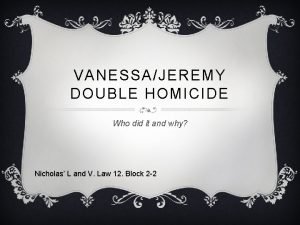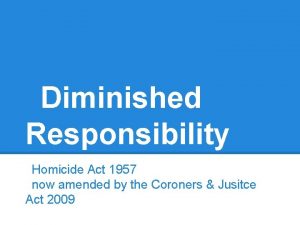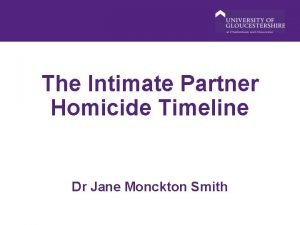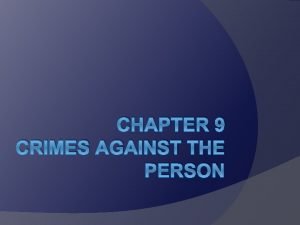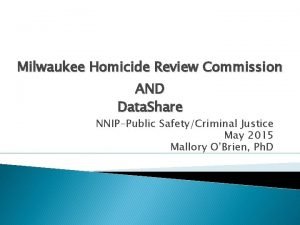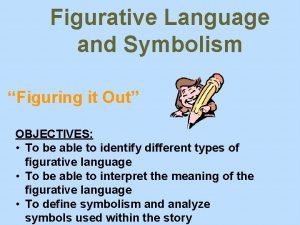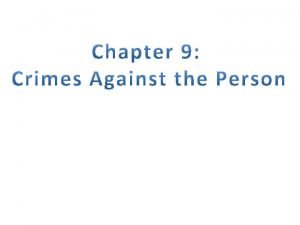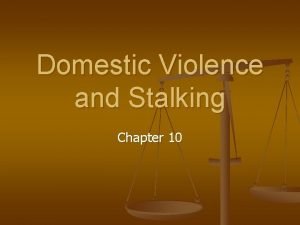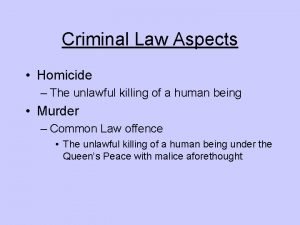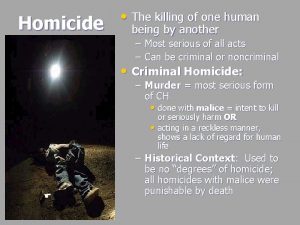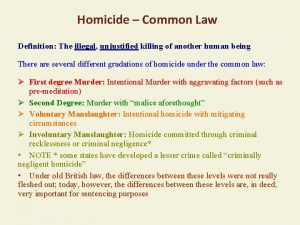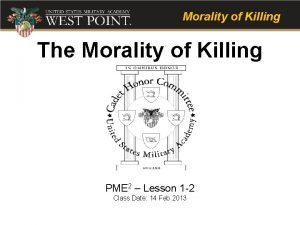Definitions l Homicide l l l The killing



















- Slides: 19

Definitions

l Homicide l l l The killing of one person by another Can be intentional or unintentional Accidents and murder

l Murder l l l Killing someone with malice of forethought. Could be done while committing another crime. Always illegal.

l First-degree murder l Killing a person with malice of forethought; the killing was planned. It was done deliberately.

l Second-degree murder l Killing done during a crime deemed dangerous to a human life. The crime was most likely not committed with the intention of killing.

l Voluntary manslaughter l Killing someone intentionally but without malice of forethought. For example, if the killing was a crime of passion (killing a spouse or lover because of jealously), the intention was to kill. However, there was no malice of forethought because it was not planned.

l Involuntary manslaughter l Killing someone unlawfully but without malice of forethought. It was committed without the intent to kill and without a conscious disregard for human life.

l Vehicular manslaughter l l Killing a person due to illegal driving of an automobile, including gross negligence, drunk driving, reckless driving or speeding. Can be a misdemeanor or a felony.

A troubled seventeen-year old girl has slowly poisoned her parents each night at dinner. After three months she came home to find them dead on the kitchen floor. The coroner’s report indicated that cyanide poisoning caused their deaths. l First-degree murder l Sentenced to life without parole l

l l l Three sixteen-year-olds were hanging out at the park drinking whiskey. One boy started shoved his friend. Soon the shoving escalated into punching. One boy tripped, and his head hit a sharp-edged rock. The boy died before help arrived. Second-degree murder Sentenced to 3 years in prison after being tried as an adult.

Suspicious that his girlfriend was cheating, a sixteen-year old boy went to her house and found her in bed with his brother. Impulsively, he grabbed the nearest lamp and hit his brother on the head. His brother died two days later. l Voluntary manslaughter l Sentenced to six years in prison l

A thirteen-year-old boy broke into an auto parts business to steal hubcaps. The seventeen-year-old security guard picked up his boss’ gun and fired two warning shots at the thief. The second shot hit the thirteen-year-old and killed him on the spot. l Involuntary manslaughter l Sentenced to 15 years to life l

Answer the following questions l l l What do the titles “Supreme Court to Rule on Executing Young Killers” and “Kids are Kids – Until They Commit Crimes” tell you the articles will be about? “Kids are Kids” was published in The Sacramento Bee. “Supreme Court to Rule” was published in The New York Times. What can you predict about the articles based on their lengths and the lengths of their paragraphs? How do you think the articles will be the same? How do you think they will be different? What issue do you think these articles are going to discuss? What positions do you think Liptak and Lundstrom will take?

Defenda Age nt Crime Sentenc e

Vocabulary in Context Constitutionality (1) Prosecutors (1) Demeanor (2) Remorse (2) Alienated (2) Nonchalant (2) Plummeting (4) Culpability (7) Mitigating (9)

Vocabulary in Context Inconsistency (6) Quandary (7) Heinous (14) Coddling (14) Perpetuated (20)

Punishing Juveniles FOR punishing juveniles AGAINST punishing like adults juveniles like adults

Answer Questions l l l l Do you think that sentencing juvenile killers to the death penalty is a “cruel and unusual” punishment? Should juveniles be punished less harshly than adults? Describe the demeanor of a teenager you know. Do you think that such a demeanor would cause a jury to be lenient? Do you think execution should be banned for some age groups of juveniles? Which age groups? What factors do you think juries should take into account when they sentence juveniles? Do you agree with Lundstrom that it is inconsistent to deny privileges like voting and drinking to teenagers but then to sentence them as adults? Why? Do you think juveniles should be tried as adults if they commit especially bad crimes? Do you agree with Lundstrom that the media perpetuates the stereotype of violent youths?

 Tosconini
Tosconini Khi n
Khi n Double homicide
Double homicide Homicide act 1957
Homicide act 1957 Arizona homicide investigators association
Arizona homicide investigators association 8 stage homicide timeline
8 stage homicide timeline Site:slidetodoc.com
Site:slidetodoc.com Milwaukee homicide review commission
Milwaukee homicide review commission Overt vs covert behavior
Overt vs covert behavior Figurative symbolism
Figurative symbolism Simulated killing philosophy
Simulated killing philosophy Monitoring of illegal killing of elephants
Monitoring of illegal killing of elephants Biting the hand that feeds you figurative language
Biting the hand that feeds you figurative language Mercy killing چیست
Mercy killing چیست Killing done with malice but without premeditation
Killing done with malice but without premeditation Killing the pig john montague
Killing the pig john montague Killing with keyboards
Killing with keyboards Killing 2 stones with 1 bird
Killing 2 stones with 1 bird Who was nongqawuse
Who was nongqawuse Killing stalking chapter 10
Killing stalking chapter 10


